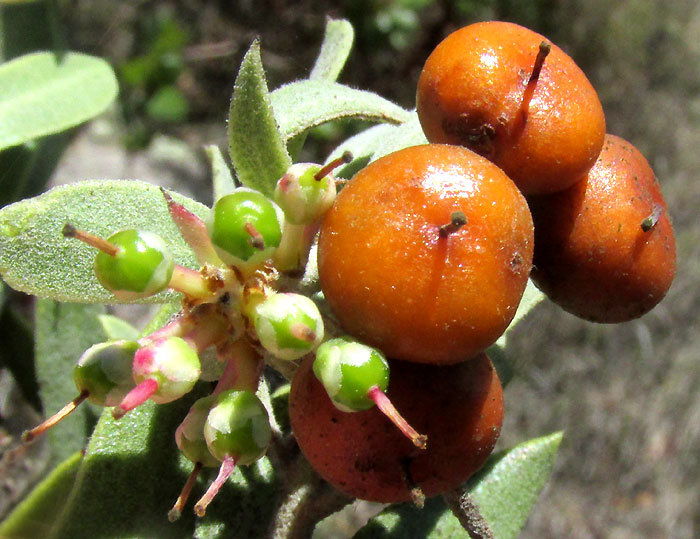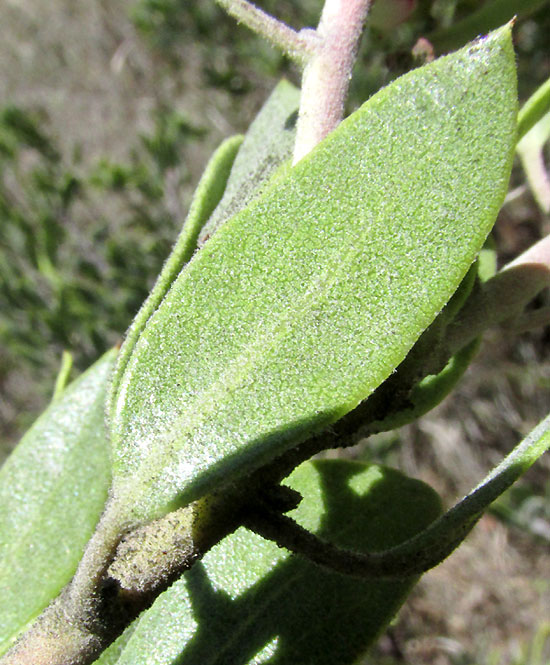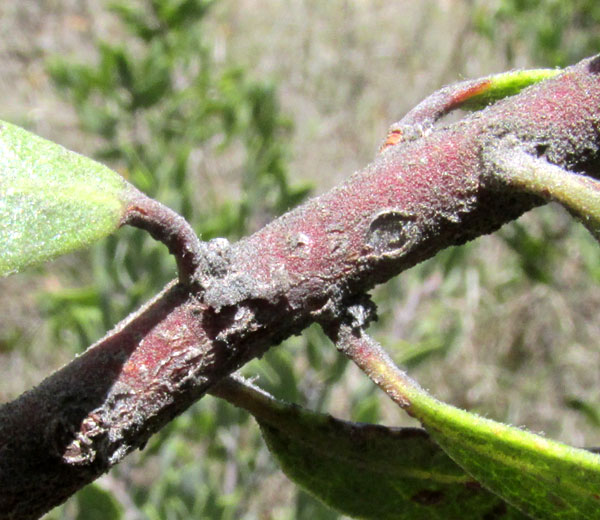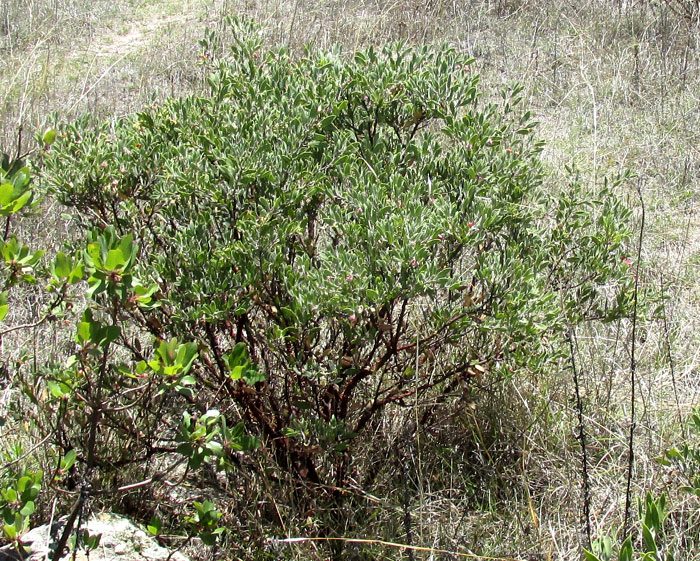Excerpts from Jim Conrad's
Naturalist Newsletter
entry from field notes dated July 2, 2022, taken on the eastern lower slope of Cerro de la Cruz, at an elevation of ~2700m (~8850 ft), just south of the community of El Pinar, Amealco de Bonfil, Querétaro, MÉXICO, (~N20.17°, ~W100.17°)
MEXICAN MANZANITA

At the lower eastern slope of Cerro de la Cruz a large abandoned field was covered mostly with scattered shrubs and clumpgrass. This year the rainy season hasn't come in May as it should have, so the grass was still gray/brown and crispy. Nonetheless, a chest-high bush with stiff, grayish-green leaves arising from smooth, reddish stems, and bearing the above flowers, seemed to be doing well.
When a woody plant has a flower like the above one, with a corolla bulging at the base but contracted above -- the shape is "urceolate" -- a good bet is that the plant is a member of the Heath Family, the Ericacea, home to such garden favorites as Azaleas and Rhododendrons.

To better see the flower's sexual parts, on one flower the corolla's top part was removed, revealing what's shown above. The green item in the center is the stigma where pollen is supposed to germinate. The stigma tops a white, columnar style, which arises atop the pale, spherical ovary, which is the future fruit. Surrounding the ovary are about eight stamens, each composed of a pale, short style atop which stands a blackish anther with two pollen-producing compartments.
These are remarkable anthers. At first I thought I'd accidentally snipped off their tops, forming the large holes. But later it was realized that the holes are normal, exactly what's needed for "buzz pollination" by visiting bees. The bees use their thoracic muscles to produce hundreds of vibrations per second, which pass through the air onto and into the anthers, knocking pollen grains around and causing them to issue through the big holes. Notice the slender, curving hairlike "awns" attached at the anther openings' rim. I suspect that these also are vibrated by the bees, magnifying the anthers' agitation. For more about buzz pollination, see the 2018 study by Mario Vallejo-Marín entitled "Buzz pollination: studying bee vibrations on flowers."

Some of the shrub's branches bore drupe-type fruits in various stages of development, as shown above. In both of the above photos, notice the dense cover of short, white hairs covering the vegetative parts. On mature stems the hairs wear off. White hairiness on leaves and young stems conserves water in the plant by reducing air flow and creating a humid microclimate next to the body surface. The whiteness reflects cell-damaging UV radiation in such open areas at high elevations where sunlight is intense.
The flower parts seen above are typical of the Heath Family. Normally that family's flowers produce twice the number of stamens as corolla lobes. Our corolla had four lobes, and we saw eight stamens. There's one ovary with one style and stigma. Leaves in the family are simple -- not divided into leaflets -- and often leathery and evergreen, but not always. Here's one of our plant's leaves:

Important for field identification is that the leaf's tip is sharply pointed with a hard "mucro." The shrub's stems beneath all that white hairiness were somewhat reddish:

And here's the shrub itself:

Already it's clear that we have a member of the the Heath Family, but it's worth noting that Heath Family species often favor acidic soils. At this location we had thin soil atop ignimbrite, which is compacted, sometimes rock-like, erupted volcanic pumice, ash and other material. Soil developed atop such volcanic substrates in semiarid climates like ours tend to be a bit acidic, as documented, for example, in the 1998 study by Didier Dubroeucq and others entitled "Weathering and soil forming processes under semi-arid conditions in two Mexican volcanic ash soils."
The Flora del Bajío treating our upland central Mexico region reports that in the Bajío the Heath Family, which specializes in cold and temperate climates, is represented by about 29 species in 12 genera. In our region, if you find a Heath Family member that's a much-branched woody bush producing smooth-surfaced, drupe-type fruits, and leaves tipped with sharp-pointed mucros, you have the genus Arctostaphylos, whose species are known in English as manzanitas. In Spanish the word manzanita means "little apple." The center of diversity for manzanita species in western North America, with 62 species, but in our part of central Mexico we have just this one species, which is ARCTOSTAPHYLOS PUNGENS, the Mexican Manzanita, in the US often called the Pointleaf Manzanita.
Mexican Manzanitas are known in the English speaking world because it's the most widespread manzanita in the southwestern US. However, mainly the species is Mexican, occurring throughout Mexico's uplands, at elevations from 1600-3200 m (5250-10,500 ft), south to Chiapas. It's common in open forests with oak and pine, as well as in evergreen scrub areas. Manzanita species are associated both with nutrient-deficient soils and highly diverse mycorrhizal fungal communities helping the shrubs thrive in such habitats. The fungal community is especially adapted for acidic soil and frequent fires.
Manzanita species specialize in frequently burned locations. Numerous manzanita species develop burls, which are rounded, knotty growths at the tree's base, which can resprout after fire has destroyed the rest of the tree. However, Mexican Manzanita produces no burls. Moreover, unlike many seeds in areas of frequent fire, Mexican Manzanita seeds have a poor survival rate after fires. It appears that their undeniable success in occupying fire-prone areas is based on their fruits being eaten by many forms of wildlife, and the dissemination into many situations, plus the seeds' hard covering, and ability to remain viable for over a hundred years. During that time, as soon as they're exposed to sufficient air and water, they germinate. Details are provided in the 2006 work by Marco A. Márquez Linares and others entitled "Algunos aspectos de la biología de la manzanita (Arctostaphylos pungens HBK) y su papel en el desplazamiento de bosques templados por chaparrales."
We've seen that the fruits look like pea-sized oranges. They're eaten both by wildlife and people, having an OK acid flavor, but they're full of hard seeds, and the flesh is a bit dry and mealy. Traditionally the fruits have been dried and ground into a meal that can be cooked into a nutritious mush, or added as flavoring in soups.
The online Atlas de las Plantas de la Medicina Tradicional Mexicana reports that traditionally infusions made with the whole plant have been drunk to cure renal tract infections, as well as to bring down fevers. Milk and Palmolive Soap can be added to the infusion to make bathwater for fevers, plus many other uses have been documented. Mexico's Instituto Médico Nacional has found that ingesting 10g of the fruits in two dosages increases urine flow and diminishes albumin.